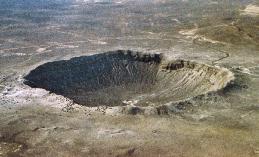Meteors and
Meteorites
 Small pieces of space debris (usually parts of comets or asteroids)
that are on a collision course with the Earth are called
meteoroids.
When meteoroids enter the Earth's atmosphere they are called
meteors. Most meteors burn up in the atmosphere, but if they
survive the frictional heating and
strike the surface of the Earth they are called meteorites.
Small pieces of space debris (usually parts of comets or asteroids)
that are on a collision course with the Earth are called
meteoroids.
When meteoroids enter the Earth's atmosphere they are called
meteors. Most meteors burn up in the atmosphere, but if they
survive the frictional heating and
strike the surface of the Earth they are called meteorites.
The Earth has been
struck by many meteorites, some quite large.
The adjacent image shows the Barringer Crater in Arizona
(Ref).
It is 1.2 kilometers across and 200 meters deep, and was
formed about 49,000 years ago
by the impact of a 50 meter nickel/iron meteorite travelling at a speed
of 11 kilometers per second.
Most meteorites are much smaller and do much less
damage, but as we shall see, in the geologically not so distant
past the Earth has probably been
struck by even larger meteorites than the one that formed the Barringer
Crater. We have already discussed the
Tunguska Event (which may have been a comet rather than an asteroid), and we shall discuss the
high probability that the
extinction of the dinosaurs
was triggered by the
impact of a massive meteorite in the Southern Caribbean region.
 Small pieces of space debris (usually parts of comets or asteroids)
that are on a collision course with the Earth are called
meteoroids.
When meteoroids enter the Earth's atmosphere they are called
meteors. Most meteors burn up in the atmosphere, but if they
survive the frictional heating and
strike the surface of the Earth they are called meteorites.
Small pieces of space debris (usually parts of comets or asteroids)
that are on a collision course with the Earth are called
meteoroids.
When meteoroids enter the Earth's atmosphere they are called
meteors. Most meteors burn up in the atmosphere, but if they
survive the frictional heating and
strike the surface of the Earth they are called meteorites.